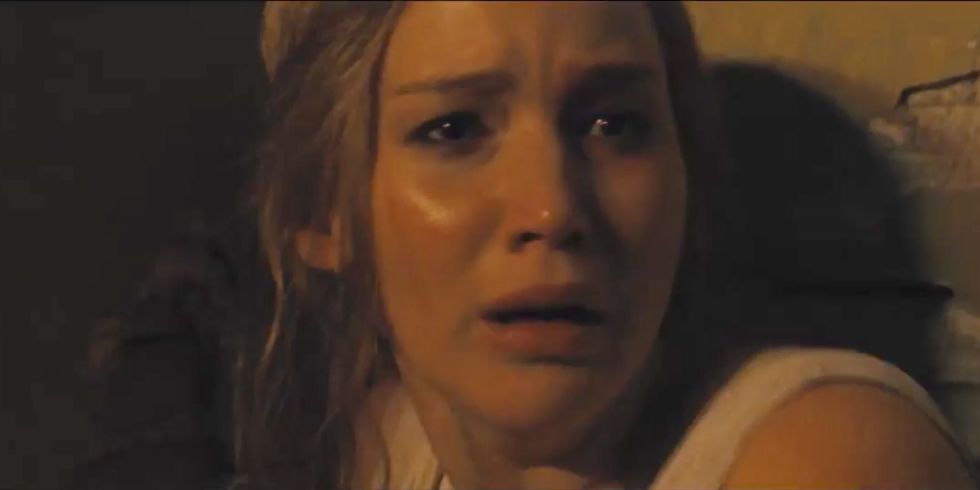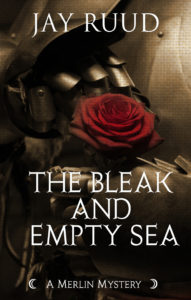mother!
Darren Aronofsky (2017)
[av_image src=’http://jayruud.com/wp-content/uploads/2014/09/SusannTennyson.jpg’ attachment=313′ attachment_size=’square’ align=’left’ animation=’left-to-right’ link=” target=” styling=” caption=’yes’ font_size=” appearance=’on-hover’]
[av_textblock size=” font_color=” color=”]
Many people—I would venture to say most people—will not like Darren Aronofsky’s new film mother! When you take a look at the movie site RottenTomatoes.com and note that 68 percent of the critics have given it a favorable review, while only 42 percent of the audience liked it, you have to wonder what could explain that large a divide. A general explanation may be that critics will often reward something bold and new with a positive rating, while the typical moviegoer is looking for something that will captivate and move him emotionally or, less often, intellectually. Mother! does spark some intellectual interest, but is so off-putting emotionally and so deliberately provocative that the majority of viewers may be disenchanted long before they are tempted to put in the effort to figure it out.
Because the movie is so bold and unusual, one difficulty that even critics who like the film have is in deciding what category of film mother! belongs to. Several critics have labeled it a horror film. While it does use certain elements of the horror genre—there’s a bit of a Rosemary’s Baby feel to it—it’s certainly not a horror movie. It is much closer to a novel by Kafka: The protagonist is put into a situation that seems to make sense at first, but then is confronted with inexplicable obstacles that suggest a world metaphysically opposed to the character’s wishes, in a plot that has the structure and coherence of a dream. In fact, even more than in Kafka, this film suggests fairly clear religious parallels to aspects of the movie’s plot. What the film is, in fact, is an allegory, not exactly a familiar genre in post-modern America. In fact, there hasn’t been a successful religious allegory in English since Bunyan’s The Pilgrim’s Progress in the 17th century.
To give you an idea of the plot, or at least the situation, of the movie, it opens with Jennifer Lawrence (yes, The Hunger Games woman) awakening alone in bed in a large, beautiful Victorian mansion, which sits in a clearing surrounded by woods. There is no visible road or driveway giving access to the house She looks around the house, searching, apparently for her husband, who seems absent. While she stands in the doorway looking out into the surrounding wood, he suddenly appears behind her, startling her. It is Javier Badem (yes, the guy from No Country for Old Men). The cast list identifies her only as “mother,” and identifies him as, well, “Him.” We never learn whether they have other names. Their isolated life seems rather lonely. She spends all her time restoring the house, which we learn was earlier burned in a fire. He spends his time brooding and staring at a blank piece of paper. He was a famous writer at one time, we learn, but has been unable to write anything for some time.
One night someone comes to their door. It is Ed Harris (billed simply as “Man”), who claims to be a doctor looking for a place to spend the night, who has been told that the couple run a bed and breakfast. The couple give him a drink, though “Him” is far more welcoming than “mother” is, and she is therefore appalled when her husband invites the strange man to stay the night. This causes some tension between the two, a tension that is only exacerbated when the following morning Michelle Pfeifer shows up (so nice to see her in a film again!). Billed as “Woman,” she turns out to be “Man’s” wife, and has come looking for him. And of course, Javier Bardem invites her to stay as well. Turns out Harris’s character is a big fan of his, and had only come there to meet him because his words “changed my life.” Well now it seems the two will be moving in indefinitely, and when “Him” and “Man” go out for a hike, “Woman” becomes incredibly inappropriate in her conversation with “mother,” prying into all kinds of personal aspects of her life with her much older husband. Lawrence’s character becomes more and more uncomfortable as “Man” and “Woman” seem oblivious and indifferent to the damage they keep causing to the perfectly ordered house she has restored.
The house is suddenly invaded by two brothers, aptly named in the cast list Older Son (Harry Potter’s—and the new Star Wars’—Domhnall Gleeson) and Younger Brother (real-life brother Brian Gleeson, recently seen in Logan Lucky). These charming boys turn out to be the offspring of “Man” and “Woman,” and immediately get into a knock-down, drag-out, no-holds-barred brawl over their inheritance and over which one mom and dad loves best. I won’t go into too much detail for fear of creating spoilers, but Javier Bardem ends up taking the group to the hospital. When he returns to the house, which “mother” has taken pains to try to put right again, her husband now tells her he has offered to hold a wake in their house. A wake that turns more and more violent as more and more guests show up, until some of them actually break a sink by bouncing up and down on it, and flood the building.
Now Aronofsky, who directed Noah, is well aware of the significance of a flood. And if you haven’t recognized it by now, it will become clear by the end of the film (which is only half over at this point) that we are dealing with an allegory of the creation stories of the Old Testament. The second half of the film gives us an allegory of the New. Where Adam and Eve, Cain and Abel, and the flood unfold in the first part of the film, the birth and death of Christ and Armageddon occur in the second half. Allegorically, of course, since it is still all narrated through the metaphor of the house, the marriage, a new baby, and thousands of uninvited guests, enamored with Javier Bardem’s new poems—his new creation. The “Him” character lives to be admired—he is so obsessed with people loving him that he overlooks the great harm they are doing to his house, his wife, his marriage, even his child. As he film ended, my wife said to me, “Well, that’s what it’s like to live with a narcissist.”
Of course, considering the film allegorically, she was just calling God a narcissist. But given the event of the film, it’s hard to deny the assessment. Why did God create human beings? Because he wanted to be loved, though in this film he doesn’t really return that love, to the people or even to “mother.” He is absent much of the time, leaving the world—the house—to fend for itself. He looks the other way when humans engage in harmful actions against themselves or others or his son (Son?), or the house (world?) itself. It is the humans who bring the flood upon themselves, and ultimately it is humans who are destroying the house in the second half of the film. As long as he is being loved, this God metes out no punishments and makes very few demands. He is self-centered and weak. The film thus underscores a problem that theologians and philosophers of religion have recognized for centuries: to describe God in human terms is to limit him, to make him into something less than he is. God is not a human. He wants humans to love him, and he forgives them their sins. He can create beautiful things to inspire human beings to love him. He will sacrifice everything for the love of the human race. But this is what that looks like when we think of God as “human” himself. Weak. Needy. Narcissistic.
But human sin is allegorized brilliantly in the film by the uncontrolled crowds of people who ruin the beautiful house, and that underscores an even more crucial theme of the film. And that is where Jennifer Lawrence comes in. The film is not called “Him,” it is called “mother.” Hers is the first face we see, and it is a face that fills the screen in extreme close-up for a huge segment of the screen time. Her face registers every emotion that the audience feels at the absurdities, the inconveniences, and ultimately the horrors that multiply in the film until its crescendo near the end. She becomes an actual mother by the film’s end, but from the beginning she is the personification of another mother—mother earth. She makes the house livable, as, allegorically, nature presents humans and other living creatures a beautiful home. As God’s first creation, the film seems to suggest, she is mindful of the world he made. The unrestrained, undisciplined destruction of the house highlights what Aronofsky has said is one of the main themes of the movie: the global warming that threatens to destroy that home because of short-sighted exploitation by those who assume the house will never collapse. Nor, the film suggests, will God ultimately step in and save us. Humans must bear the responsibility and suffer the consequences for their own willful destruction.
When the credits roll, the old Skeeter Davis song from the 60s, “The End of the World,” plays you out of the theater. It’s something of a shock with its gentle, pop ballad tone, but it truly tells us what the movie was about.
Nothing in this film would work without Lawrence, with whom our sympathies lie throughout, so that Aronofsky compels us to see the destruction through the eyes of Nature herself. It’s a huge burden that Lawrence is able to carry. Bardem is fairly unlikeable as Him, though never overtly tyrannical, vengeful, or judgmental. He’s just passive-aggressively narcissistic, needy, and he never pays any regard to his wife’s feelings. Some have suggested he is the image of the self-involved artist, and hence an ironic self-portrait of Aronofsky himself. But again, if he’s the omnipotent God, he reminds us how unsatisfactory it may be to imagine God in human terms. Bardem plays these contradictory aspects brilliantly.
In the end, mother! is a powerful, thought-provoking movie-allegory, but one that fails to communicate its message to a large segment of its audience, who are put off by what seems incoherence, by scenes of what seem gratuitous violence and disgust, and by the use of a genre little understood by today’s audiences. I’m giving it two Jacqueline Susanns and half a Tennyson. But be warned. It’s not rated R for “religious.”
And by the way, if you like reading these reviews, you might be interested in Jay Ruud’s new “Merlin Mystery” novel, the third in the series, which will be released on November 10 and now available for pre-ordering on Amazon and on Barnes and Noble:
When word comes to Camelot that Sir Tristram has died in Brittany of wounds suffered in a skirmish, and that his longtime mistress, La Belle Isolde, Queen of Cornwall, has subsequently died herself of a broken heart, Queen Guinevere and her trusted lady Rosemounde immediately suspect that there is more to the story of the lovers’ deaths than they are being told. It is up to Merlin and his faithful assistant, Gildas of Cornwall, to find the truth behind the myths and half-truths surrounding these untimely deaths. By the time they are finally able to uncover the truth, Gildas and Merlin have lost one companion and are in danger of losing their own lives.
Pre-order from Amazon here: https://www.amazon.com/Bleak-Empty-Sea-Tristram-Mystery/dp/1893035735/ref=sr_1_1?s=books&ie=UTF8&qid=1503328086&sr=1-1&keywords=Bleak+and+Empty+Sea
https://www.merlinsilk.com/neologism/ Pre-order from Barnes and Noble here: https://www.barnesandnoble.com/w/the-bleak-and-empty-sea-jay-ruud/1126958139?ean=9781893035737


